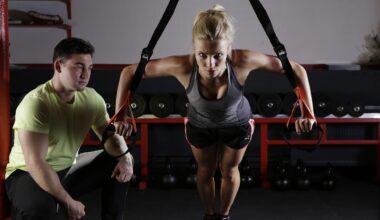The Best Functional Training Bodyweight Exercises for Seniors
As we age, maintaining physical fitness becomes increasingly essential. Bodyweight exercises are particularly beneficial for seniors, providing strength and flexibility without the need for specialized equipment. These workouts enhance stability, balance, and coordination, making everyday activities easier and safer. Here are some of the best bodyweight exercises designed specifically for individuals over sixty. These exercises can be modified to accommodate varying fitness levels and are perfect for building a functional fitness foundation. From chair exercises to standing moves, seniors have many options available. Always remember to start conservatively and consult your physician before beginning any new exercise regimen. A consistent routine can significantly enhance your quality of life, promoting independence and reducing injury risk. Regular engagement in these exercises contributes to improved joint mobility, increased muscle strength, and enhanced overall well-being. Embrace the journey and discover how enjoyable maintaining fitness can be while staying active at home or in a simple class setting. Incorporating these bodyweight exercises into a regular fitness plan will lead to incredible benefits, making daily tasks more manageable and lifting your spirits.
One exceptional bodyweight exercise for seniors is the sit-to-stand. This functional movement improves leg strength and enhances overall mobility. To perform this exercise, position yourself in front of a sturdy chair with your feet shoulder-width apart. Slowly lower yourself into the chair without using your hands, then rise back up to a standing position. Repeat this movement for several repetitions, focusing on maintaining proper form. Adding a slight pause at the chair helps increase strength. Additionally, the wall push-up is another fantastic option. Stand a few feet away from a wall, place your hands against it at shoulder height, and lean in while bending your elbows. Push back to the starting position, engaging your chest and arms. This exercise can be executed at various heights depending on your comfort level, and it significantly aids in upper-body strength. Incorporating these two exercises into your weekly routine can yield remarkable results. Be sure to listen to your body and adjust as necessary, ensuring it aligns with your fitness goals while you continue building strength and endurance in a safe environment.
Dynamic Movements for Enhanced Mobility
Leg raises are an excellent way to bolster hip strength and enhance core stability. Begin by sitting on the edge of a sturdy chair, with your back straight and feet flat on the floor. Slowly raise one leg straight in front of you while keeping your knee straight, ensuring it remains level with your hips. Hold for a few seconds, then lower your leg back down. Repeat on both sides for several reps to work your quadriceps and improve balance. Another great exercise is the side leg lift, which targets your hip abductors and helps increase lateral stability. Standing while holding onto a countertop or chair, lift one leg straight out to the side without tilting your torso. Lower it back to the ground, maintaining control. Perform this exercise on both legs to help in developing balance and coordination, essential for daily tasks. Finally, consider incorporating gentle toe taps to the front, side, and back; these movements promote flexibility and improve stability over time. Combined, these exercises create a functional workout that can promote healthier aging.
Additionally, the wall sit is a fantastic choice that builds isometric strength and endurance in the lower body. To perform this exercise, find a wall and stand with your back against it. Lower your body into a sitting position, with your knees at a right angle, resembling sitting in a chair. Hold this position for as long as you can, aiming to increase time with each attempt. A great variation is the tandem stance, where you practice balancing on one foot in front of the other. This exercise also improves balance and can be modified by holding onto a wall or sturdy surface until confidence grows. Engaging in these exercises promotes stability and significantly reduces fall risks. Moreover, stamina and lower body endurance directly correlate with enhanced mobility and independence. Consistency in performing these exercises contributes positively to daily living activities. As with any fitness regimen, it’s paramount to listen to your body and work within your limits. The goal is to gently push yourself to improve strength without risking injury or strain to ensure longevity in your fitness journey.
Core Engagement for Stability
Engaging the core is crucial for seniors seeking functional strength. A straightforward seated twist helps in enhancing spinal mobility and core strength. Sit on a chair with feet flat and hands clasped together at your chest. Slowly twist your torso to one side, engaging your abdominal muscles, and hold for five seconds before returning to the center and twisting to the other side. This exercise not only strengthens the core but also improves flexibility and balance. Next, consider performing modified plank exercises. An effective plank variant involves leaning against a wall at an angle, which makes the exercise less intense while still engaging your core. Hold the position for ten seconds, focusing on breathing and activating your core muscles. Aim to gradually build your time in this position, benefiting spinal alignment and overall strength. Also, you can incorporate bird-dogs while kneeling on a soft surface. Extending one arm and the opposite leg promotes stability and coordination, particularly vital for daily functionality, contributing significantly to improved balance while enhancing core engagement further.
As seniors work on their functional training, it is essential to maintain proper hydration and nutrition. Adequate fluid intake supports muscle function, aids recovery, and ensures overall health. Nutritionally, focusing on a balanced diet rich in lean proteins, whole grains, and vegetables plays a vital role in supporting overall fitness. After performing these bodyweight exercises, refueling your body helps promote muscle repair. Prioritize meals that encompass all the essential nutrients required for recovery to optimize strength building and endurance. Furthermore, consider a regular stretching routine post-exercise to enhance flexibility. Various light stretches can reduce tension built up in muscles during strength training and render them more pliable for daily activities. Stretches such as arm circles, seated forward bends, and gentle neck stretches improve mobility and maintain joint health. Engaging in consistent stretching routines will help promote body awareness, allowing seniors to maintain proper posture throughout their movements. These combined strategies leverage the benefits of bodyweight exercises and naturally enhance physical fitness levels, contributing positively toward a healthier lifestyle while nurturing emotional and social well-being.
Creating a Functional Training Routine
Establishing a functional training routine can be a straightforward and rewarding experience for seniors. Start by setting specific fitness goals based on individual needs and capabilities. Assessing your current fitness level provides insight into what exercises to begin with, ensuring they align with your goals while maintaining safety. Consider scheduling workouts three to five times weekly, lasting around twenty to thirty minutes each session. Engaging in a warm-up is crucial; activities such as marching in place or arm circles prepare muscles. Balancing different exercises from this article creates a well-rounded program targeting various body parts. Incorporate lower body, upper body, and core activities to ensure comprehensive strength and flexibility. Consistent feedback on progress helps in making adjustments as needed to keep challenging yourself. Additionally, encouraging social interaction in group classes can improve adherence to fitness schedules. Remember, the journey towards improved functional fitness is about celebrating small victories, which instills motivation and promotes long-lasting commitment. Ultimately, enjoying these activities contributes greatly to a sustainable, healthier lifestyle during the golden years of life.
In conclusion, adopting functional training bodyweight exercises empowers seniors to maintain independence and mobility. Utilizing simple movements can significantly improve strength, balance, and flexibility, which are crucial for daily living. As each individual navigates their fitness journey, tailoring these exercises to match personal abilities ensures safety and effectiveness. Always consult with healthcare providers when starting a new regimen, especially if there are existing health concerns. Cultivating a habit of movement and staying active contributes positively to overall health, longevity, and quality of life. As you embrace these activities, celebrate your progress, recognizing that every small step leads to larger achievements over time. Incorporating functional bodyweight exercises not only supports physical well-being but also nurtures emotional health, creating a holistic approach to aging gracefully. Take advantage of the resources available online or seek guidance from local fitness professionals to enhance knowledge and application of these exercises. Ensure you listen to your body, take rest when needed, and enjoy the process. Functional training exercises will empower you to lead a fulfilling life, filled with joy and independence. Keep striving for improvement and enjoy your active aging journey!


